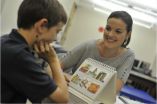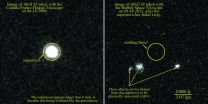Resuming blood pressure medicine promptly after surgery reduces risk of death
2015-06-04
(Press-News.org) Chicago - June 4, 2015 - It may be better for patients to resume taking their blood pressure medication sooner after surgery than previously thought. A new study published in the Online First edition of Anesthesiology, the official medical journal of the American Society of Anesthesiologists® (ASA®), found resuming angiotensin receptor blockers (ARBs), common medications used to treat high blood pressure, within two days after surgery decreased death rates in the first month following surgery.
"Sometimes doctors briefly stop ARB medications around the time of surgery because they are known to cause low blood pressure while under general anesthesia, which can be dangerous for the patient," said Susan Lee, M.D., lead author of the study and clinical instructor, department of anesthesia and perioperative care, University of California, San Francisco. "Our study highlights the importance of resuming medications that patients were previously taking at home as soon as it is feasible after surgery."
In the study, researchers examined more than 30,000 patients who were regularly taking ARB medication prior to surgery and were admitted to the Veterans Affairs Healthcare system for non-cardiac surgery between 1999 and 2011.
Nearly one third (10,205) of the patients studied did not have their usual ARB medication resumed within two days of their operation. The delay in restarting ARBs was associated with an increase in death rate within 30-days of surgery, when compared to those whose medication had been promptly resumed. The effect was greater in patients under 60 years old. Researchers also found reduced rates of infection, pneumonia, heart failure and kidney failure in patients whose ARB medications were resumed soon after surgery, suggesting that early resumption may also reduce complications after surgery.
Until now and despite their widespread use, there has been little information to guide physicians in the optimal timing for restarting ARBs after surgery. Doctors may continue to withhold ARB medication after surgery because they are concerned the medication may cause dangerously low blood pressure or disrupt kidney function. However, even after accounting for these complications in the first two days after surgery, resuming ARB medication was associated with a 50 percent lower mortality rate in the first month after surgery.
Immediately following surgery, patients are often transferred to different units within the hospital. Previous research has found that some regularly prescribed medications may not get resumed during these "transitions of care." Last year, the ASA introduced the Perioperative Surgical Home (PSH), a physician-led, patient-centered, multidisciplinary team-based model of coordinated care. With physician anesthesiologists at the helm of the PSH model helping to ensure patient safety and quality of care throughout the entire surgical process - from admission to recovery and post-discharge - the PSH model stands to improve and standardize patient processes like "medication reconciliation," ensuring a patient's medications are resumed appropriately during the surgical process.
INFORMATION:
THE AMERICAN SOCIETY OF ANESTHESIOLOGISTS
Founded in 1905, the American Society of Anesthesiologists (ASA) is an educational, research and scientific society with more than 52,000 members organized to raise and maintain the standards of the medical practice of anesthesiology. ASA is committed to ensuring that physician anesthesiologists evaluate and supervise the medical care of patients before, during, and after surgery to provide the highest quality and safest care that every patient deserves.
For more information on the field of anesthesiology, visit the American Society of Anesthesiologists online at asahq.org. To learn more about the role physician anesthesiologists play in ensuring patient safety, visit asahq.org/WhenSecondsCount.
ELSE PRESS RELEASES FROM THIS DATE:
2015-06-04
A 333-million year old broken bone is causing fossil scientists to reconsider the evolution of land-dwelling vertebrate animals, says a team of palaeontologists, including QUT evolutionary biologist Dr Matthew Phillips, and colleagues at Monash University and Queensland Museum.
Analysis of a fractured and partially healed radius (front-leg bone) from Ossinodus pueri, a large, primitive, four-legged (tetrapod), salamander-like animal, found in Queensland, pushes back the date for the origin of demonstrably terrestrial vertebrates by two million years, said Dr Phillips, ...
2015-06-04
Research by Catherine Klein, an undergraduate in Bristol's School of Earth Sciences, shows that fossils from the previously unstudied Woodleaze Quarry belong to a new species of the 'Gloucester lizard' Clevosaurus (named in 1939 after Clevum, the Latin name for Gloucester).
In the Late Triassic, the hills of the South West of the UK formed an archipelago that was inhabited by small dinosaurs and relatives of the Tuatara, a living fossil from New Zealand. The limestone quarries of the region have many caves or fissures containing sediments filled with the bones of abundant ...
2015-06-04
New research has revealed that parasitic 'vampire' plants that attach onto and derive nutrients from another living plant may benefit the abundance and diversity of surrounding vegetation and animal life.
By altering the densities of the hemiparasite (a parasitic plant that also photosynthesises) Rhinanthus minor, in the Castle Hill National Nature Reserve in Sussex, ecologists from the Universities of York, Sussex and Lincoln were able to assess the impacts of the 'vampire' plants on the biodiversity of a species-rich semi-natural grassland. The scientists compared ...
2015-06-04
NORTH GRAFTON, Mass. (June 4, 2015)--Birds, like people, can suffer from conditions where a blood transfusion is a necessary life-saving measure. But in many instances, unless an avian donor is readily available, accessing blood is impossible because of the challenges associated with storing the species' red blood cells.
New research published in the American Journal of Veterinary Research has found that a substance called dimethyl sulfoxide (DMSO) shows promise as a potential cryopreservant for freezing avian blood.
"Birds are susceptible to various causes of blood ...
2015-06-04
In many animal species, the chromosomes differ between the sexes. The male has a Y chromosome. In some animals, however, for example birds, it is the other way round. In birds, the females have their own sex chromosome, the W chromosome. For the first, researchers in Uppsala have mapped the genetic structure and evolution of the W chromosome.
Every individual of a species has the same sorts of chromosomes, with one exception. In many species, the way the sexes differ is that males have their own sex chromosome, the Y chromosome. This contains genes which result in the ...
2015-06-04
ARLINGTON, Texas -- Toys, appliances, and even a sofa and coffee table can impact the way or when a baby first crawls, walks or achieves other growth milestones, but a new UT Arlington study finds that many parents are unaware of the significant role household items play in their infant's motor skill development.
Priscila Caçola, an assistant professor of kinesiology in the UT Arlington College of Nursing and Health Innovation, co-developed a simple questionnaire for caregivers of infants aged 3 to 18 months that she says can aid in the evaluation of toys and other ...
2015-06-04
From AGU's blogs: Flooding, erosion risks rise as Gulf of Mexico waves loom larger
Waves in the northern Gulf of Mexico are higher than they were 30 years ago, contributing to a greater risk of coastal erosion and flooding in Florida, Alabama, Mississippi and Louisiana, according to a new study in Geophysical Research Letters.
From Eos.org: Building Sandbars in the Grand Canyon
Annual controlled floods from one of America's largest dams are rebuilding the sandbars of the iconic Colorado River, according to a new article by U.S. Geological Survey scientists in Eos. ...
2015-06-04
Sharp images obtained by the Hubble Space Telescope confirm that three supernovae discovered several years ago exploded in the dark emptiness of intergalactic space, having been flung from their home galaxies millions or billions of years earlier.
Most supernovae are found inside galaxies containing hundreds of billions of stars, one of which might explode per century per galaxy.
These lonely supernovae, however, were found between galaxies in three large clusters of several thousand galaxies each. The stars' nearest neighbors were probably 300 light years away, nearly ...
2015-06-04
AURORA, Colo. June 3 -- As America's obesity epidemic continues to grow, a new study from the University of Colorado Anschutz Medical Campus shows that a low-cost, non-profit weight loss program offers the kind of long-term results that often elude dieters.
'We know that people lose weight and then gain it back,' said study author Nia S. Mitchell, M.D., MPH, a researcher with the Division of General Internal Medicine at the Anschutz Health and Wellness Center at CU Anschutz. 'In this case, we found that people who renewed their annual membership in the program lost a ...
2015-06-04
One of the most widely used tools in epigenetics research - the study of how DNA packaging affects gene expression - is chromatin immunoprecipitation (ChIP), a technique that allows researchers to examine interactions between specific proteins and genomic regions. However, ChIP is a relative measurement, and has significant limitations that can lead to errors, poor reproducibility and an inability to be compared between experiments.
To address these issues, scientists from the University of Chicago have developed a new technique that calibrates ChIP experiments with an ...
LAST 30 PRESS RELEASES:
[Press-News.org] Resuming blood pressure medicine promptly after surgery reduces risk of death

